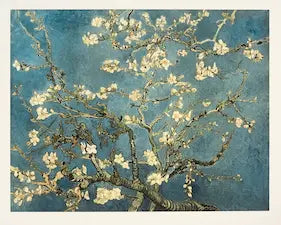The Trumpet Shop Vintage Prints
Van Gogh "Almond Blossom" print | 1890 Post-Impressionism | High-Quality Reproduction
Van Gogh "Almond Blossom" print | 1890 Post-Impressionism | High-Quality Reproduction
Couldn't load pickup availability
⭑ 🇬🇧 Printed & dispatched from UK 🇬🇧 ⭑
- 200gsm premium art paper
- Tracked delivery within 10 days
- Free replacement guarantee
Celebrate new beginnings with this stunning Vincent van Gogh "Almond Blossom" print. Painted in 1890 as a gift for his newborn nephew, this beautiful piece is a symbol of new life and hope. The painting's vibrant blue background and elegant flowering branches show the strong influence of Japanese art on Van Gogh's work. It is a masterpiece that captures the joy and delicate beauty of a blooming tree.
Our high-quality Almond Blossom reproduction meticulously preserves the rich textures and subtle color variations of the original. Each piece is produced using archival Giclée printing on thick, premium paper, ensuring exceptional clarity and color fidelity that will last a lifetime.
This Van Gogh floral print is a perfect addition to a living room, bedroom, or nursery. For lovers of classic art, flowers, or anyone who appreciates iconic beauty, this unique piece of Almond Blossom wall art makes an exceptional gift.
Discover more about Vincent Van Gogh
Get more inspiration in choosing vintage wall art for a bedroom
Related collections
Share


